ISSN ONLINE(2319-8753)PRINT(2347-6710)
ISSN ONLINE(2319-8753)PRINT(2347-6710)
Namrata Yannawar1, G.R.Patil2
|
| Related article at Pubmed, Scholar Google |
Visit for more related articles at International Journal of Innovative Research in Science, Engineering and Technology
Tuned liquid damper is a passive damper used to control the structural vibration in structures. It is properly designed, partially filled with liquid (mostly water) is either a rigid rectangular or a cylindrical tank which is rigidly connected to the top of structure and is used as a vibration absorber. The container may be a large tank or a combination of many small tanks. Their main function is to absorb portion of the input energy associated with external dynamic excitation acting on the structure. In this paper, a water tank is been designed which acts as tuned liquid damper. This tank is been placed at the top of a three storied framed model. The model is been experimented with tuned liquid damper and without tuned liquid damper on shake table set-up along with accelerometers connected to it. The experiment is conducted with the help of sine vibration control software. The following readings are obtained in the entire three axes. Considering the displacements in all the three directions graph has been plotted. Further, a comparison is been carried out of displacements of framed model with and without water tank at the top floor.
Keywords |
| Excitation, Dynamic, Tuned Liquid Damper, Vibration Absorber. |
I. INTRODUCTION |
| In olden days, engineer’s use to practice the technique which not only gave strength to the structure but also prompted greater resonance. Later, to overcome this modern engineer’s invented methods which would provide desired strength without increase in their resonance. This method aimed not only the stability of the structure but also controlled the structure during times of stress. This method is universally named as Structural Control and was first documented in early 1800s. Since then a lot of research work has been carried out and still a lot new technique using this method is been tired by a lot of scientist in different parts of the world. A professor named John Milne in 1970’s was the first to successfully use this technique. He isolated the entire structure from ground and successfully provided minimal damping to the structure. |
| Structural Controlling devices endure shaking effect by absorbing and dissipating seismic energy. Structural Control device are classified into 4 types:- active, hybrid, semi-active and passive. Passive device are very effective and easy to maintain. Once installed these device requires no sensors, actuators or controllers as compared to the other three categories. The only disadvantage of this device is that, after installation the device is not capable of taking any new challenges and hence in this case, it becomes necessary to replace the device. |
| In passive devices, oscillations of the entire mechanism affects directly to the amplitude and direction of the controlling forces. The energy required for passive systems to create the control forces in produced, not by external influences, but rather “through the motion of the mechanism during dynamic excitement”. Although there are numerous types of passive control systems, four systems are most popular: tuned mass damper (TMD), base isolation, frictional dampers, viscoelastic dampers, fluid viscous dampers and tuned liquid damper (TLD). |
| A TLD consists of a rigid tank, partially filled with a liquid, usually water. When a structure, fitted with a properly tuned TLD begins to sway during a dynamic loading event, it causes fluid sloshing motion inside the tank. The fluid sloshing motion imparts inertia forces approximately anti-phase to the dynamic forces exciting the structure, thereby reducing structural motion. The inherent damping mechanism of the TLD dissipates the energy of the fluid sloshing motion. Tuned liquid dampers (TLDs) are cost effective and low-maintenance dynamic vibration absorbers that are being used in flexible and lightly damped structures. |
II. EXPERIMENTAL SET-UP |
| This consists of four aluminum columns and four aluminum slabs each attached to the four columns at an interval of 400 mm. The entire structure assembly (figure 1) is placed on a ED Vibration Shaker table driven by an electric motor. The ED shaker system has a capacity of 3000 kgf (Sine/Random) 6000 kgf (Shock).The Slip table is of size 600 mm X 600 mm. The RPM of the motor can be varied to achieve harmonic base motions at different frequencies. |
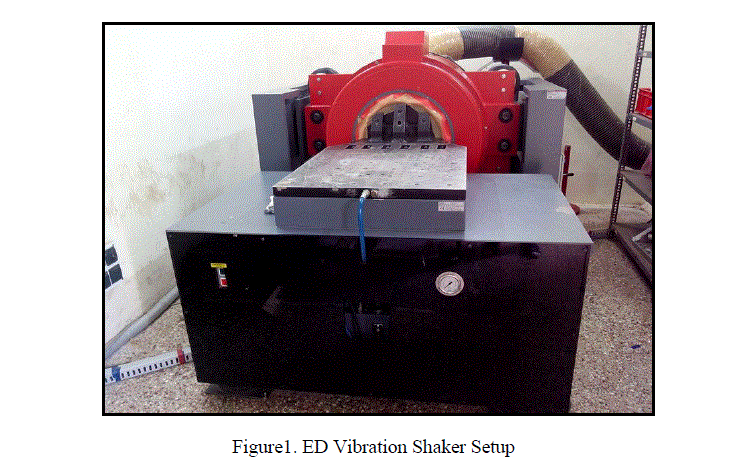 |
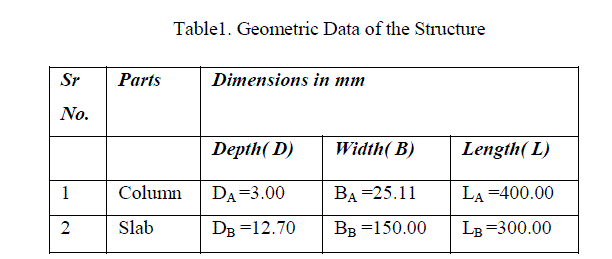 |
| The frame is rectangular in plan with stiffness and mass properties distributed uniformly in plan as well as in elevation. The frame is designed to facilitate the visualization of the first three mode shapes with bare eyes. The model shown in figure 2 can be thought of as a model for a building frame with three floors which suffers earthquake like base motions. The model however is an idealized demonstration of this phenomenon since the building can only be subjected to harmonic base motions. The frequencies of the base motion can be varied by changing the RPM of the electric motor; it is possible to vary the amplitude of the base motion by adjusting the stroke. By changing the motor RPM it would be possible to set the frame into resonant motions, which would enable to visualize the first three normal modes of the frame. Here in the experiment the behavior of a three storied building frame model subject to harmonic base motions. |
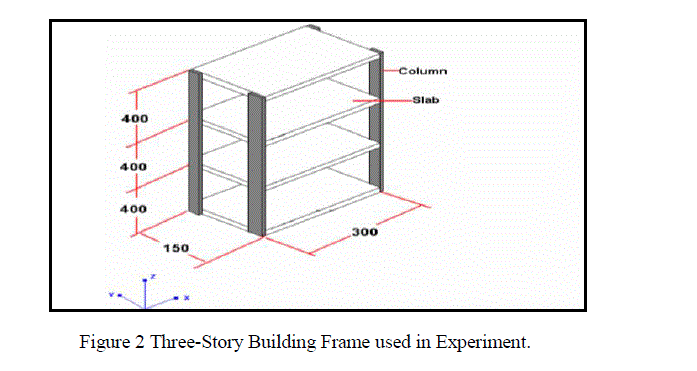 |
| Design of water tank |
| The fundamental sloshing frequency of a TLD, fTLDïÿýïÿýïÿýïÿýïÿýïÿýïÿýïÿý can be estimated using linear water sloshing frequency, |
 |
| Where, g = acceleration due to gravity |
| h = still water depth |
| L = length of tank in the direction of sloshing motion. |
 |
III. DAMPER STRUCTURE ARRANGEMENT |
| The water tank designed is used as damper for the structure. The tank is placed at the top of the structure. the length of the Damper considered is 96 mm. The width of the damper considered is 100 mm. For height of water equal to 100 mm, first natural frequency of water is 2.84 rad/sec, which is equal to 99.9% of fundamental frequency of structure. Therefore height of water considered is 100 mm. The density of the water is 1000Kg/m3. Then the experiment is conducted with the frame is placed on the ED vibration shaker and accelerometers have been connected to each floor i.e. the base, first floor, second floor and the top floor. The accelerometer provides the displacement that occurs in the entire frame when a vibration of the shaker starts. Each accelerometer provides displacements at each floor. The frequency range starts from 2 Hz up to 40 Hz. However, the frequency in each floor hardly exceeds the frequency of 35 Hz. |
IV. EXPERIMENTAL RESULTS |
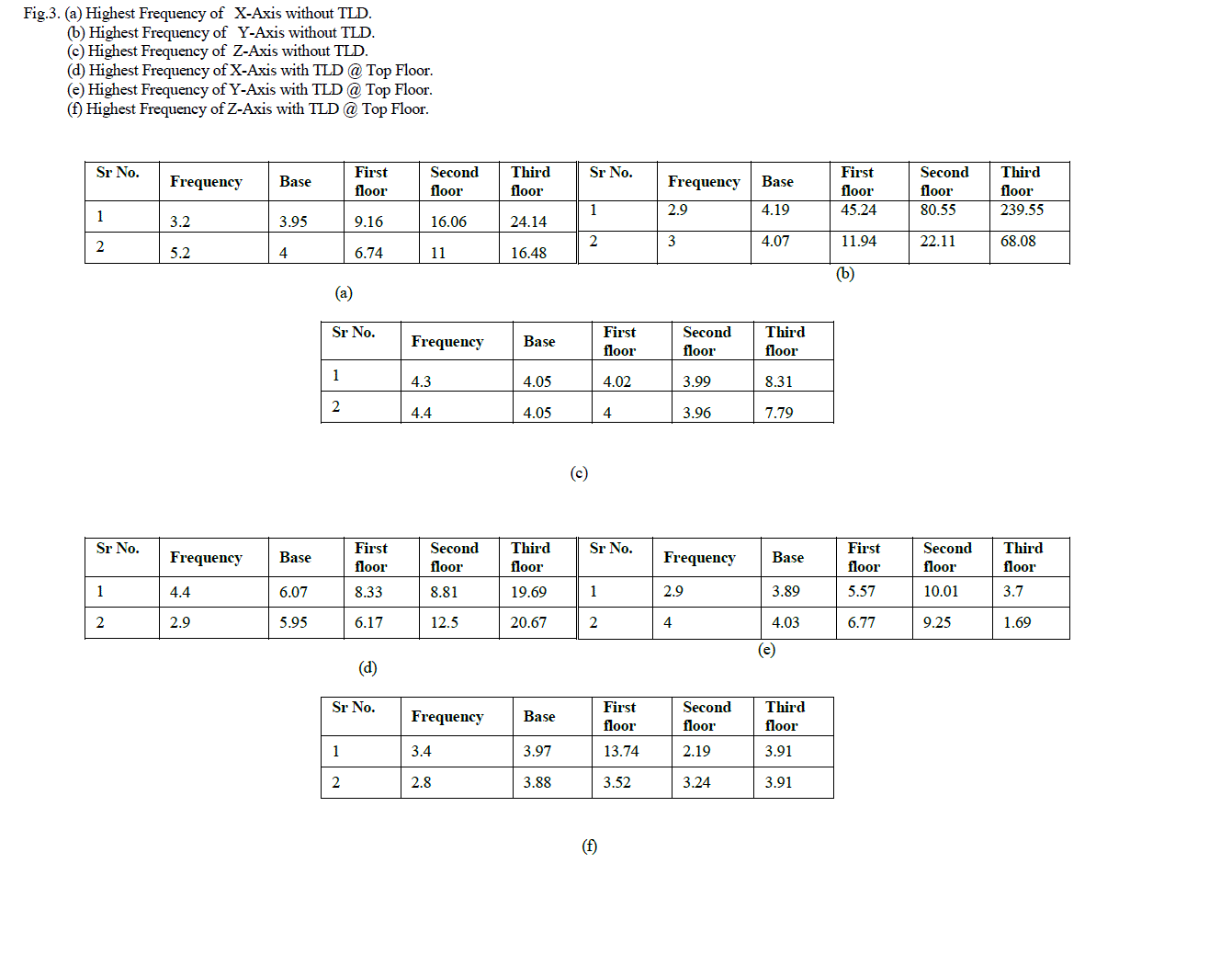 |
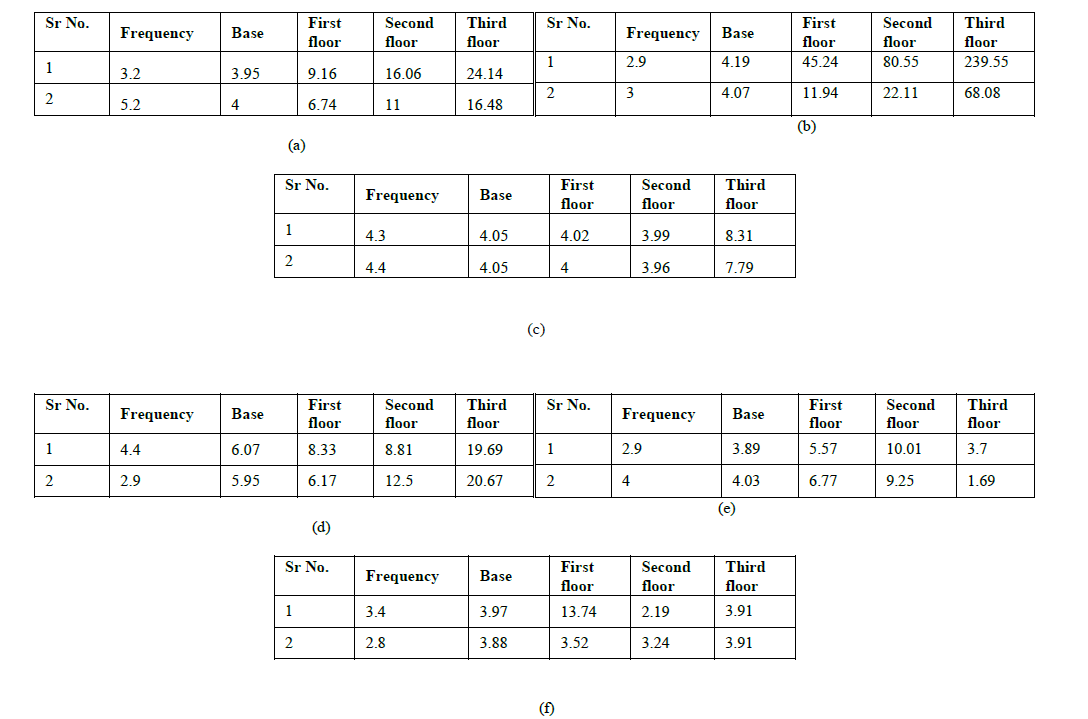 |
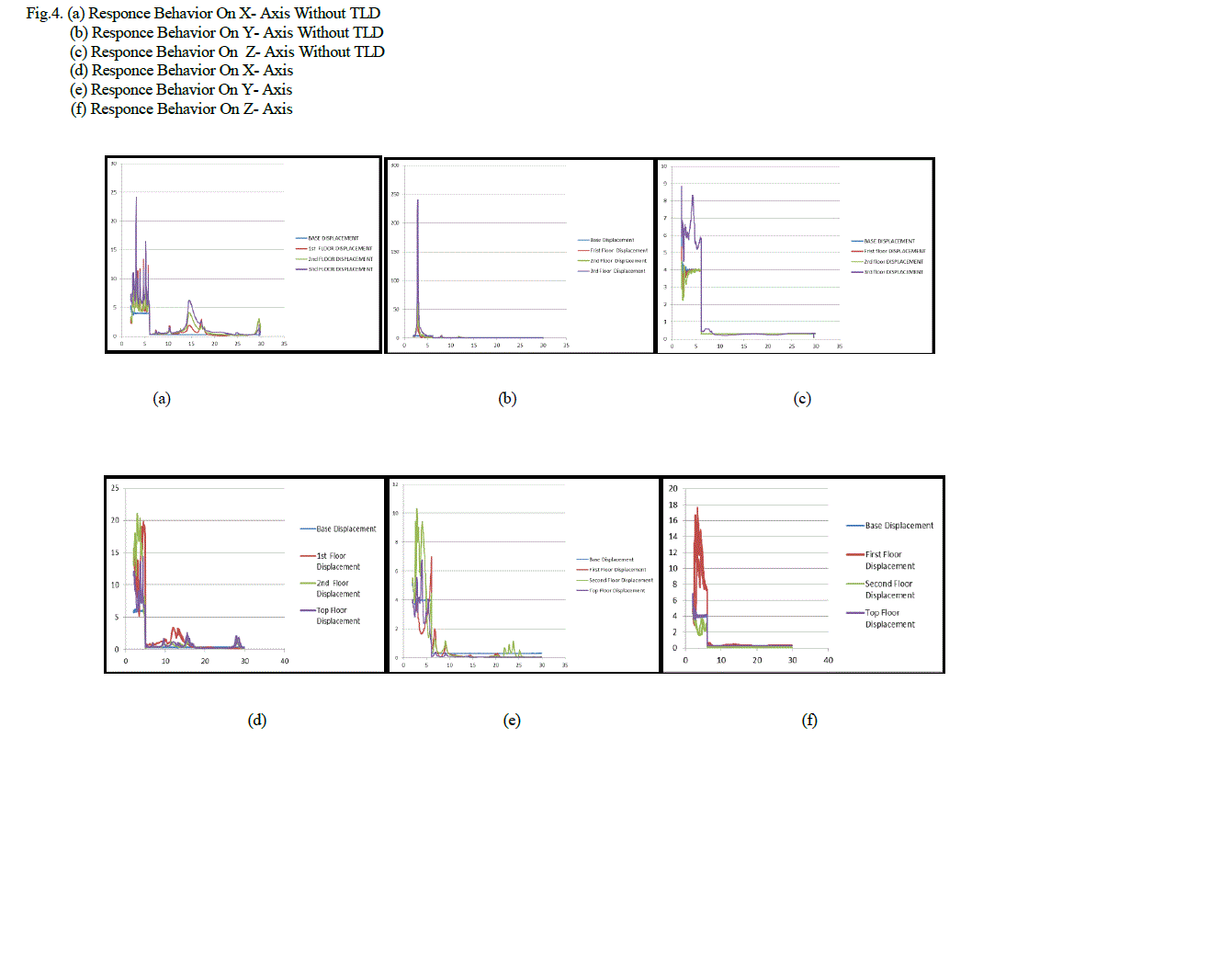 |
 |
| In table fig. 3 (a), the vibration is considered along the length, the reading that has been shown in the table is the one which had maximum displacement. As it is seen in the table that when the TLD was not placed on the frame the displacement in the top floor was maximum as compared to other floors. In table fig. 3 (b), the vibration is considered along the breadth, the reading that has been shown in the table is the one which had maximum displacement. As it is seen in the table that when the TLD was not placed on the frame the displacement in the top floor was maximum as compared to other floors which proves the damage that will be caused at the top will be almost thrice more that the second floor and almost 90% more than the base. In table fig. 3 (c), the reading that has been shown is along the height; here the displacement is very less as compared to the other two directions. However, the displacement at the top floor is again maximum as compared to the other floors. In table fig. 3 (d), the vibration is considered along the length, the reading that has been shown in the table are the one which had maximum displacement. As it is seen in the table that when the TLD was placed on the frame the displacement in the top floor was minimum as compared to the displacement of the frame without TLD. Thus it proves that the difference in displacement is large and TLD dissipates the displacement to an extent. In table fig. 3 (f), the reading that has been shown is along the height; here the displacement is is less in the second floor it is more than the displacements of the second floor in the other two directions. However, the displacement at the top floor is again minimum as compared to the other floors. In table fig. 3 (e), the vibration is considered along the breadth, the reading that has been shown in the table is the one which had maximum displacement. As it is seen in the table that when the TLD was placed on the frame the displacement in the top floor was minimum as compared to the displacement in the frame which is without TLD which proves the damage that has occurred is very less in the entire frame and almost 90% less at the top floor. Fig. 4 a, b ,c, d, e and f shows the graphs of frequency in the x-axis versus displacement in the y-axis. |
V. CONCLUSION |
| From the graph, it’s is seen that the displacement in the x-axis, y-axis and z-axis without water tank is more than the displacement with water tank placed at the top. Thus, it can be said that when the water tank is placed at the top of the frame and when the experiment is conducted it was proved that the water tank acts as a tuned liquid damper and it dampens the displacement to the minimum. |
References |
|